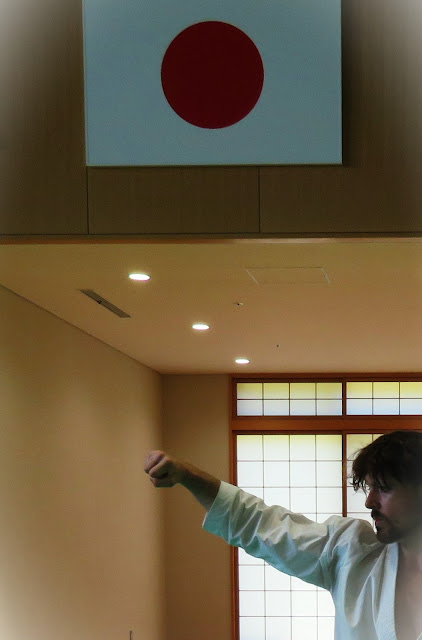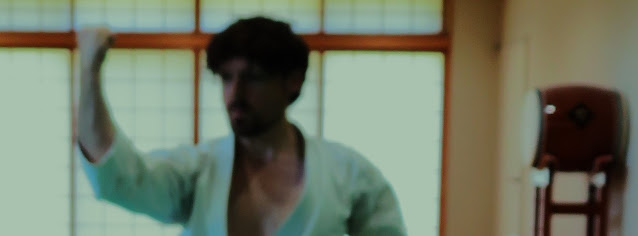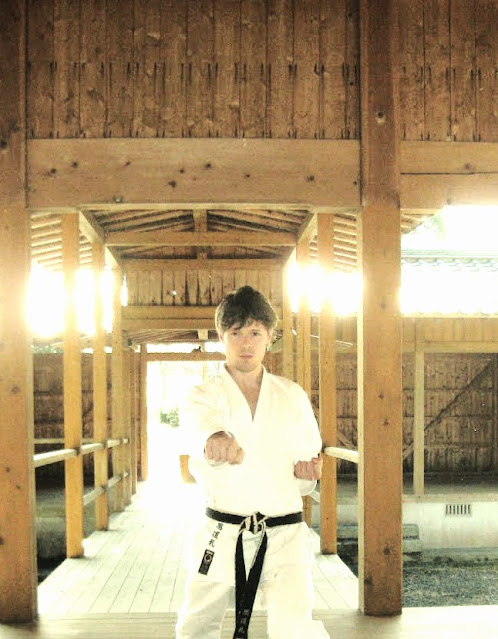© André Bertel. Oita City, Japan (2023).
This site is based on my daily practice of Shotokan Karate-Do here in Oita City, Japan. More than anything else, unlike the majority of other karate websites, this page is primarily dedicated to Budo Karate training itself; that is, Karate-Do as a vehicle for holistic development.
Monday, 29 May 2023
火手 (Kashu)
Friday, 19 May 2023
Formula in learning and refining excellent karate stances
Over the years I’ve been kindly commented on about my 立ち方 (tachikata/stances) by
several of the Shotokan legends here in Japan. Sharing these compliments, which
have referred to classical form and applicable robustness—is not will to brag
here—but, rather, to explain my formula in learning and refining excellent
karate stances FOR YOU. In sum, if you follow these rules, ‘you will literally
have the best tachikata’.
Before I do that I need to elucidate two key points:
Firstly, if winning sports kata competitions is your main objective, what I’m going to present in this article is not ideal for you. My training and teaching of the Shotokan tachikata is traditional/classical; that is, strength, stability, mobility and optimal functionality of karate techniques = a beautiful stance. Put another way, a lot of the stances in sports karate to us budo karateka are meaningless and counterproductive; thus, actually seen as being seen as both bizarre and actually ugly.
Secondly, and directly relating to the aforementioned point, I must therefore define the traditional/classical tachikata: the ‘beautiful Shotokan stance’. This stance has the ideal configurations for the individual. These are largely determined by THREE FACTORS: (1) the stance must not distort the posture; (2) the stance must not dictate the directions of the feet and full placement of them on the floor; and (3) the stance must be optimal for oneself; that is, maximize one’s own ability to move and deliver the most destructive waza possible.
Please allow me expand on these three factors:
Factor One: ‘the stance must not distort the posture’.
If the karateka’s shisei (posture) is broken “…from a too deep and/or too long tachikata”, your body is literally telling you that you need to lessen either the depth, length, or both. No, there’s nothing wrong with a very large scale stance, but there’s nothing wrong with smaller stances either. Kawasoe Masao Sensei, based in the UK, has very short stances, but they are perfect. Interestingly, if you do stances according to your own body type and condition like Mr. Kawasoe, they are not only effective but are also aesthetically great. Of course, as one ages (and acquires injuries) this also changes, but that is the beauty of karate mastery.
Always remember, “when the posture breaks, its time to ease up on your stance size in some way”.
Factor Two: ‘the stance must not dictate the directions of the feet and full placement of them on the floor’.
This is the same as ‘Factor One’. When too long and/or too low, if you cannot place your feet correctly, your body is telling you ‘you’re wrong’. Accordingly, like posture, adjust based on not losing form. In particular, take special note of your 足刀 (sokuto/sword foot) which is the outside edges of the feet.
Factor Three: ‘the stance must be optimal for oneself; that is, maximize one’s own ability to move and deliver the most destructive waza possible’.
This is functionality, namely to attain: (1) “optimization
of velocity” via ground power, the hips and core, and elasticity/softness/snap;
and (2) “maximizing one’s mass”, via propulsion/moving the center in all eight
directions, and in various ways. Asai Tetsuhiko Sensei taught this in his
unique form of 進行方向
(SHINKO-HOKO), which many of my advanced Japanese students always request to
learn more of and refine.
So, now I’ve covered these points I want to tell you
something, which I initially stated. If you follow these points, you will
discover the best stances for yourself. That is, the most functional and,
ironically, the most beautiful—from a traditional/classic Shotokan context.
Lastly, having rules means that we must also break them! Certainly, the stances are no different, and we naturally experience this is freestyle.
押忍 — André
© André Bertel. Oita City, Japan (2023).
Saturday, 13 May 2023
受け技 (ukewaza): A simple analysis to 'begin' receiving correctly
Rapid and compact chambering of the five core foundational 受け技 (ukewaza) of
Shotokan-ryu is of ultimate importance.
This is because this initial action is the prime defense;
that is, the reactive movement. Clearly, the second action of a two-motion waza
will inherently fail against a single motion attack such a 突き技 (tsukiwaza).
Once this is fully understood, both of the main aspects of
the ukewaza can be physically expressed and pragmatically applied. The first
point here is that 決め
(Kime) can be achieved: via an initially sharp reflexive action followed by an
explosive rebound or expansion—体の伸縮
(tai no shinshuku—‘the contraction and expansion of the body’). The second
point is that one can follow the initial reactive defense with a secondary
defense or, more often, “…use the completion of the ‘uke’ as a counterattack”.
Let’s look at both actions—‘the one/two—in the five core
ukewaza (please note — to be concise in my descriptions I’ve only covered waza
‘completed’ on the right side).
上段揚げ受け
(Joudan age uke) — Upper level rising reception
1. Sasho jodan age-uke doji ni uken migi koshi.
2. Uken
jodan age-uke doji ni saken hidari koshi.
中段外受け
(Chuudan soto uke) — Middle level outside reception
1. Saken chudan hiji suri-uke doji ni migi hiji jodan yoko age-uke.
2. Uken
chudan soto-uke doji ni saken hidari koshi.
中段内受け
(Chuudan uchi uke) — Middle level inside reception
2. Uken
chudan uchi-uke doji ni saken hidari koshi.
下段払い
(Gedan barai) — Lower level sweep
1. Uken jodan soto nagashi-uke doji ni saken gedan gamae
2. Uken
gedan barai doji ni saken hidari koshi.
手刀中段受け (Shuto chuudan uke) — Sword hand middle level reception
1. Hidari
chudan yoko shihon nukite doji ni usho jodan soto nagashi uke.
2. Migi shuto
chudan uke (uchi) doji ni sasho suigetsu mae gamae.
To conclude, irrespective of these generic points of Shotokan karate, via 'dissecting the waza in this way' one can begin to travel down the rabbit hole of the greats here in Japan: in regards to the core ukewaza. Of course, this is just the beginning, however and needless to say, “…the beginning is a very important place to really begin”.
© André Bertel. Oita City, Japan (2023).
Wednesday, 10 May 2023
Sunday, 7 May 2023
Renshusei from Christchurch, New Zealand: Roger Cudmore
Roger Cudmore (Sandan), from Christchurch, New Zealand, came for training and to catch up. Roger has been a member of the dojo there for 20 years. Over the last two decades his son Harvey (Nidan) and two of his daughters, Clare and Charlotte, also trained with the Christchurch Dojo. They also were in my Canterbury team at the New Zealand National Championships, and trained with my karate master, Asai Tetsuhiko Sensei.
His training request was a "...focus on fine points, tailored to him", on ‘core 基本技 (Kihonwaza—the fundamental techniques)’ of Shotokan-Ryu.
I was very happy about his request and used it to combine solo
practice, impact training and, overall, effective application in jiyu-kumite
and self-defense. My comments herein are reminders for Roger for after he returns home from Japan (and perhaps some video footage will be uploaded later to augment this post).
An important focal point was on the 'first official Shotokan
kata': 平安初段
(Heian Shodan). In particular, I emphasized higher levels of precision in: (a)
the unsoku/leg movements; (b) hip action—largely determined by the unsoku and
hanmi and shomen zenkutsu-dachi; and (c) large scale waza. Of course, Heian
Shodan is brutal as one cannot hide errors and weakness; hence, making it
invaluable regardless of experience.
In that light we also covered kata 鉄騎三段
(Tekki Sandan) and 半月
(Hangetsu). In particular, the correctly coordinated timing of the limbs and
torso; furthermore, of this aspect moving. Simplification of shisei/posture (eradicating any unnecessary actions) was a high priority in these regards. SHOMEN was stressed when in shomen; moreover, shomen was also stressed when rotating the hips (into hanmi and gyaku-hanmi. This is an imperative point!
Overall, it was wonderful to spend time in and out of-the dojo with Roger. So, I’d like to thank him here. I also hope that the private training he received will contribute towards his ongoing karate development. A big ありがとうございます (Arigatou gozaimasu) to you Roger and have safe journey home! Until next time, 押忍 (OSU)!!
© André Bertel. Oita City, Japan (2023).
Thursday, 4 May 2023
Basic form of practicing 刻み突き (kizami-zuki) and 逆突き (gyaku-zuki) in stationary zenkutsu-dachi.
This brief article will outline some key points pertaining to the most basic form of practicing 刻み突き (kizami-zuki) and 逆突き (gyaku-zuki) in stationary zenkutsu-dachi. This is, of course, is the most common Shotokan ‘isolation practice’ of basic 腰の回転 (KOSHI NO KAITEN): in general sonoba-kihon training. Overall, I hope that this post will be useful via analysis of this ‘base practice’, which underpins the freestyle kihon and, ultimately, optimal application in jiyu-kumite and self-defense . 押忍 ― AB.
1.0 Preparatory position:
Assume hidari zenkutsu-dachi with hidari gedan-barai rotating the hips into hanmi. From here slowly extend migi seiken chudan gyaku-zuki rotating the hips into shomen. Relax the breathing, sink into the seika tanden, and free/externalize your mind to the environment; that is, free reception to any stimuli.
1.1 Slow motion practice and basic details:
Slowly rotating into hanmi make hidari seiken jodan kizami-zuki targeting the jinchu. Then counter rotate into shomen making migi seiken chudan gyaku-zuki. For kizami-zuki push with the heel of the lead left foot utilizing the axis of the rear hip; furthermore, slightly bend the rear knee whilst rolling the upper thigh subtlety outward. For gyaku-zuki push with the heel of the rear right foot utilizing the axis of the front hip. Use the straightening of the rear leg to turn the hip around and forwards.
With both tsuki keep the front knee as stable as possible
with little or, ideally no movement. Also, keep the face and head set in place
and shisei (posture)—neck, backbone and pelvis—completely erect and aligned at
all times.
Subtlety exhale on each tsukiwaza reserving around 30
percent of breath in the hara. These exhalations should nearly be
imperceptible.
1.2 Basic details of full speed practice:
If any points in the slow motion practice are sacrificed, it
means one is moving too fast for their technical ability; thus, training will
actually reduce one’s skill and by grooving bad habits into basic form.
Accordingly, aim for precision gradually building speed
without cheating yourself. Both tsuki, especially the kizami-zuki must be full
and possess kime. An important note here is the connection to ukewaza followed
by secondary waza. Kime must always be achieved in every waza.
The kiai when used must be done and applied correctly. ‘Kiai
with tsukiwaza, keriwaza and uchiwaza’ are short and sharp, in a single
syllable to concentrate power. Furthermore, they applied at the point of impact
when the respective waza begins to go through the respective target. In
traditional budo karate, theatrics have no place, thus a ‘poker face’
accompanies the kiai. Contrast this with sports karate where the dramatic
‘kabuki facial expression’ and the ‘fog horn kiai’ are now the norm.
Please take note about tachikata. Both feet in
zenkutsu-dachi must remain fully in contact with the floor with special
attention on the sokuto (sword foot) of the rear leg. Obviously, some people
with high arches cannot precisely achieve this aesthetically. But this doesn’t
matter in budo karate. What matters is the pressure to sokuto. Even with a high
arch and space under the foot: this waza can therefore still be
perfect.
Furthermore, the length of zenkutsu-dachi is the maximum
length without hindering a full and proper shomen, and the turning of the rear
foot beyond 45 degrees. Be sure to have the head of the front legs knee
directly above your toe tips with the front foot inverted one toe-width inward.
Naturally disallow the front knee to collapse inwards, but do not unnaturally
push it outwards. Imagine a triangle formed by the front knee/thigh and rear
legs outer hip joint when locked into shomen. This is the shime of the hips. In
addition to rotating the hips, the corresponding hip must be pushed slightly
forward with the corresponding tewaza. In sum, even when stationary ‘attack
with your stance’. If shomen cannot be fully achieved, one can slightly pull
back the head of the front knee; however, this must be carefully balanced to
avoid power loss and reduction of stability.
Lastly, besides correct stance, form, trajectory and strong
‘karada no buki’ (in this case, seiken) when moving fast “…concentrate on speed
as opposed to power”. In fact, try to use no conscious muscle contractions but,
rather, throw the fists out with maximum looseness and snap. This is utterly
imperative practice when training waza without a target. In this way, optimal
movement will be developed, and individual muscular (maximum) capacity can be
exceeded. In addition to increasing speed, power and fluidity, this makes one’s
waza harder to be detected by an opponent.
1.3 Generic practice routine/overview:
Practice One: 10 slow repetitions, one thrust per count.
Practice Two: 10 quick repetitions, one thrust per count with a kiai on the tenth and final waza.
Practice Three: 10 quick repetitions, both thrust per count with a kiai on the tenth and final gyaku-zuki.
Practice Four: 10 quick repetitions, both thrust per count with a kiai on every gyaku-zuki.
Practice Five to Eight: Repeat on the opposite side.
1.4 The criticality of 'level-up' practice:
Above this base training of kizami-zuki and gyaku-zuki there are numerous exercises. While we also do these waza in idokihon practice, beyond this it is absolutely essential to practice them from jiyu-dachi with jiyu na kamae: applying maximum TAI NO SHINSHUKU. In this regard, the most important training is: (1) Uchikomi practice on a partner or partners (such as a ‘line up’); (2) Full contact impact training on moving focus mitts, the sandbag, etcetera; and (3) Jiyu Kumite.
In sum, the basic training and freestyle training are
inseparable once one advances to high kyu and, certainly, at shodan and above.
Without the basic form of practice, one will never acquire the characteristic
kime that ‘makes karate’ karate. Likewise, without the thorough ‘freestyle
practice’ of waza, one will never be able to make their respective actions
reliable in a freestyle context. Hence, “…the traditional waza will be nothing
more than a sub-effective relic”.
© André Bertel. Oita City, Japan (2023).



.JPG)






